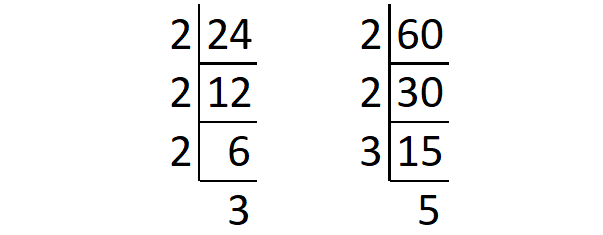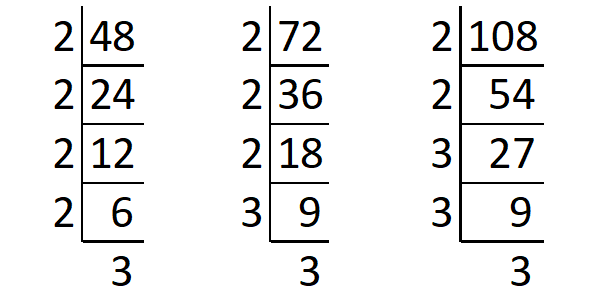LEAST COMMON MULTIPLE BY PRIME FACTORIZATION
Subscribe to our ▶️ YouTube channel 🔴 for the latest videos, updates, and tips.
Least common multiple is the smallest number which is a multiple of the given numbers.
For example, consider the numbers 4 and 5.
The whole numbers which are multiples of both both 4 and 5 are
20, 40, 60, 80, ..........
All the above numbers are multiples of both 4 and 5.
Can we get a whole number less than 20 which is a multiple of both 4 and 5?
NO, we CAN'T.
So, 20 is the smallest whole number which is a multiple of both 4 and 5.
In other words, 20 is the smallest whole number which is evenly divisible by both 4 and 5.
Therefore, 20 is the least common multiple of 4 and 5.
More Examples :
Least common multiple of 2 and 3 = 6
Least common multiple of 4 and 6 = 12
Least common multiple of 3 and 6 = 6
The following steps would be useful to find the least common multiple of the given numbers using prime factorization.
Step 1 :
Find the prime factors of the given numbers
Step 2 :
Take each prime factor with its maximum times of repetitions.
Step 3 :
Multiply all the prime factors in step 2 to get the least common multiple of the given numbers.
In each case, find the least common multiple of the numbers by prime factorization.
Example 1 :
4 and 6
Solution :
Resolve the given numbers into their prime factors.

From the above division,
4 = 2 x 2
6 = 2 x 3
The different prime factors are 2 and 3.
The prime factor 2 appears a maximum of 2 times in the prime factorization of 4.
The prime factor 3 appears a maximum of 1 time in the prime factorization of 6.
Therefore, the least common multiple of 4 and 6 is
= 2 x 2 x 3
= 12
Example 2 :
2 and 3
Solution :
There is no common divisor for 2 and 3 other than 1. So, 2 and 3 are relatively prime.
To get least common multiple of relatively prime numbers, we have to multiply them.
Therefore, the least common multiple of 2 and 3 is
= 2 x 3
= 6
Example 3 :
4 and 5
Solution :
There is no common divisor for 4 and 5 other than 1. So, 4 and 5 are relatively prime.
To get least common multiple of relatively prime numbers, we have to multiply them.
Therefore, the least common multiple of 4 and 5 is
= 4 x 5
= 20
Example 4 :
3 and 6
Solution :
Since 3 is a prime number, we don't have to resolve it into prime factors anymore.
Resolve 6 into its prime factors.

From the above division,
6 = 2 x 3
3 is already a prime number.
3 = 3
The different prime factors are 2 and 3.
The prime factor 2 appears a maximum of 1 time in the prime factorization of 6.
The prime factor 3 appears a maximum of 1 time in the prime factorization of 6 and 3.
Therefore, the least common multiple of 3 and 6 is
= 2 x 3
= 6
Example 5 :
12 and 18
Solution :
Resolve 12 and 18 into their prime factors.

From the above division,
12 = 2 x 2 x 3
18 = 2 x 3 x 3
The different prime factors are 2 and 3.
The prime factor 2 appears a maximum of 2 times in the prime factorization of 12.
The prime factor 3 appears a maximum of 2 times in the prime factorization of 18.
Therefore, the least common multiple of 12 and 18 is
= 2 x 2 x 3 x 3
= 36
Example 6 :
24 and 60
Solution :
Resolve 24 and 60 into their prime factors.

From the above division,
24 = 2 x 2 x 2 x 3
60 = 2 x 2 x 3 x 5
The different prime factors are 2, 3 and 5.
The prime factor 2 appears a maximum of 3 times in the prime factorization of 24.
The prime factor 3 appears a maximum of 1 time in the prime factorization of 24 and 60.
The prime factor 5 appears a maximum of 1 time in the prime factorization of 60.
Therefore, the least common multiple of 24 and 60 is
= 2 x 2 x 2 x 3 x 5
= 120
Example 7 :
4, 5 and 8
Solution :
Since 5 is a prime number, we don't have to resolve it into prime factors anymore.
Resolve 4 and 8 into their prime factors.

From the above division,
4 = 2 x 2
8 = 2 x 2 x 2
5 is already a prime number.
5 = 5
The different prime factors are 2 and 5.
The prime factor 2 appears a maximum of 3 times in the prime factorization of 8.
The prime factor 5 appears a maximum of 1 time in the prime factorization of 5.
Therefore, the least common multiple of 4, 5 and 8 is
= 2 x 2 x 2 x 5
= 40
Example 8 :
48, 72 and 108
Solution :
Resolve 48, 72 and 108 into their prime factors.

From the above division,
48 = 2 x 2 x 2 x 2 x 3
72 = 2 x 2 x 2 x 3 x 3
108 = 2 x 2 x 3 x 3 x 3
The different prime factors are 2 and 3.
The prime factor 2 appears a maximum of 4 times in the prime factorization of 48.
The prime factor 3 appears a maximum of 3 times in the prime factorization of 108.
Therefore, the least common multiple of 48, 72 and 108
= 2 x 2 x 2 x 2 x 3 x 3 x 3
= 432
Example 9 :
4, 6, 8 and 12
Solution :
Resolve 4, 6, 8 and 12 into their prime factors.

From the above division,
4 = 2 x 2
6 = 2 x 3
8 = 2 x 2 x 2
12 = 2 x 2 x 3
The different prime factors are 2 and 3.
The prime factor 2 appears a maximum of 3 times in the prime factorization of 8.
The prime factor 3 appears a maximum of 1 time in the prime factorization of 6 and 12.
Therefore, the least common multiple of 4, 6, 8 and 12 is
= 2 x 2 x 2 x 3
= 24
Example 10 :
2, 3, 4 and 5
Solution :
There is no common divisor for all the four numbers 2, 3, 4 and 5. So, the given numbers are relatively prime.
To get least common multiple of relatively prime numbers, we have to multiply them.
Therefore, the least common multiple of 2, 3, 4 and 5 is
= 2 x 3 x 4 x 5
= 120
Example 11 :
2, 4, 5 and 8
Solution :
Since 2 and 5 are prime numbers, we don't have to resolve them into prime factors anymore.
Resolve 4 and 8 into their prime factors.

From the above division,
4 = 2 x 2
8 = 2 x 2 x 2
2 and 5 are already prime numbers.
2 = 2
5 = 5
The different prime factors are 2 and 5.
The prime factor 2 appears a maximum of 3 times in the prime factorization of 8.
The prime factor 5 appears a maximum of 1 time in the prime factorization of 5.
Therefore, the least common multiple of 2, 4, 5 and 8 is
= 2 x 2 x 2 x 5
= 40
Example 12 :
3, 6, 7 and 14
Solution :
Since 3 and 7 are prime numbers, we don't have to resolve them into prime factors anymore.
Resolve 6 and 14 into their prime factors.

From the above division,
6 = 2 x 3
14 = 2 x 7
3 and 7 are already prime numbers.
3 = 3
7 = 7
The different prime factors are 2, 3 and 7.
The prime factor 2 appears a maximum of 1 time in the prime factorization of 6 and 14.
The prime factor 3 appears a maximum of 1 time in the prime factorization of 6 and 3.
The prime factor 7 appears a maximum of 1 time in the prime factorization of 14 and 7.
Therefore, the least common multiple of 3, 6, 7 and 14 is
= 2 x 3 x 7
= 42
Subscribe to our ▶️ YouTube channel 🔴 for the latest videos, updates, and tips.
Kindly mail your feedback to v4formath@gmail.com
We always appreciate your feedback.
About Us | Contact Us | Privacy Policy
©All rights reserved. onlinemath4all.com

Recent Articles
-
10 Hard SAT Math Questions (Part - 44)
Jan 12, 26 06:35 AM
10 Hard SAT Math Questions (Part - 44) -
US Common Core K-12 Curricum Algebra Solving Simple Equations
Jan 07, 26 01:53 PM
US Common Core K-12 Curricum Algebra Solving Simple Equations -
10 Hard SAT Math Questions (Part - 4)
Jan 05, 26 06:56 PM
10 Hard SAT Math Questions (Part - 4)
